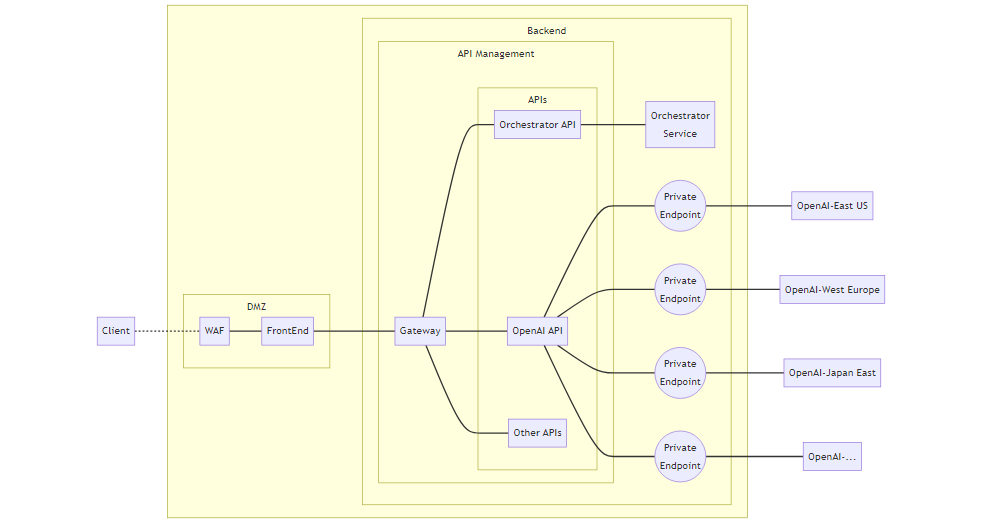Azure OpenAI Network Hardening
In my last two posts, I shared how you could load balance multiple OpenAI instances using Azure API Management and using Azure Application Gateway. The reality of enterprise organization requirements, however, is much more complicated. The key challenge is that enterprise organizations do not like exposing PUBLIC endpoints. This is a short post on reference architectures to meet network hardening requirements.
Network Hardening using Private Endpoints
A private endpoint is a network interface that uses a private IP address from your virtual network. This network interface connects you privately and securely to a service that’s powered by Azure Private Link. By enabling a private endpoint, you’re bringing the service into your virtual network (source: here.)
Azure Cognitive Services, including Azure OpenAI, supports private endpoints. This allows us to, say, deploy a private endpoint in a Southeast Asia region Virtual Network that is linked to a West Europe Azure OpenAI resource. With private endpoints, the following network architectures are possible:
flowchart LR
Client -.- WAF
subgraph VirtualNetwork[ ]
subgraph DMZ
WAF --- FE
end
subgraph BE[Backend]
FE[FrontEnd] --- O
O[Orchestrator<br />Service] --- AppGW[Application<br />Gateway]
AppGW --- A((Private<br />Endpoint))
AppGW --- B((Private<br />Endpoint))
AppGW --- C((Private<br />Endpoint))
AppGW --- D((Private<br />Endpoint))
end
end
A --- AOAI[OpenAI-East US]
B --- BOAI[OpenAI-West Europe]
C --- COAI[OpenAI-Japan East]
D --- DOAI[OpenAI-...]
flowchart LR
Client -.- WAF
subgraph VirtualNetwork[ ]
subgraph DMZ
WAF --- FE
end
subgraph BE[Backend]
SPACEBE[<br />]
FE[FrontEnd] --- GW
subgraph APIM[API Management]
SPACEAPIM
GW[Gateway] --- OAPI
GW --- Others
GW --- OAIAPI
subgraph APIs
OAPI[Orchestrator API]
OAIAPI[OpenAI API]
Others[Other APIs]
end
end
OAPI --- O[Orchestrator<br />Service]
OAIAPI --- A((Private<br />Endpoint))
OAIAPI --- B((Private<br />Endpoint))
OAIAPI --- C((Private<br />Endpoint))
OAIAPI --- D((Private<br />Endpoint))
end
end
A --- AOAI[OpenAI-East US]
B --- BOAI[OpenAI-West Europe]
C --- COAI[OpenAI-Japan East]
D --- DOAI[OpenAI-...]
style SPACEBE fill:transparent,stroke:transparent,color:transparent;
style SPACEAPIM fill:transparent,stroke:transparent,color:transparent,height:1px;
Isolated OpenAI Virtual Network
In some cases, an organization’s policy might only allow Azure resources for specific regions (e.g. restricted to Southeast Asia only).
Since Azure OpenAI deployment to multiple regions is the recommended way to address tokens-per-minute limitations, the cloud administration team may consider an exception for Azure OpenAI — through an exempted (separate) Azure Subscription with a very tailor-fit Azure Policy. The main subscription can connect to the external subscription via Private Link to an Azure Application Gateway:
flowchart LR
Client -.- WAF
subgraph VirtualNetwork[ ]
subgraph DMZ
WAF --- FE
end
subgraph BE[Backend]
FE[FrontEnd] --- O
O[Orchestrator<br />Service] --- PE((Private<br />Endpoint))
end
end
subgraph S[Separate Subscription/VNET]
PE -- private link --- AppGW[Application<br />Gateway]
AppGW --- A((Private<br />Endpoint))
AppGW --- B((Private<br />Endpoint))
AppGW --- C((Private<br />Endpoint))
AppGW --- D((Private<br />Endpoint))
end
A --- AOAI[OpenAI-East US]
B --- BOAI[OpenAI-West Europe]
C --- COAI[OpenAI-Japan East]
D --- DOAI[OpenAI-...]
flowchart LR
Client -.- WAF
subgraph VirtualNetwork[ ]
subgraph DMZ
WAF --- FE
end
subgraph BE[Backend]
SPACEBE[<br />]
FE[FrontEnd] --- GW
subgraph APIM[API Management]
SPACEAPIM
GW[Gateway] --- OAPI
GW --- Others
GW --- OAIAPI
subgraph APIs
OAPI[Orchestrator API]
OAIAPI[OpenAI API]
Others[Other APIs]
end
end
OAPI --- O[Orchestrator<br />Service]
OAIAPI --- PE((Private<br />Endpoint))
end
end
subgraph S[Separate Subscription/VNET]
PE -- private link --- AppGW[Application<br />Gateway]
AppGW --- A((Private<br />Endpoint))
AppGW --- B((Private<br />Endpoint))
AppGW --- C((Private<br />Endpoint))
AppGW --- D((Private<br />Endpoint))
end
A --- AOAI[OpenAI-East US]
B --- BOAI[OpenAI-West Europe]
C --- COAI[OpenAI-Japan East]
D --- DOAI[OpenAI-...]
style SPACEBE fill:transparent,stroke:transparent,color:transparent;
style SPACEAPIM fill:transparent,stroke:transparent,color:transparent,height:1px;
Additional Components
In implementing the above, do not forget the other components that needs to be considered, such as:
- Ports (mainly port 443), which is configured in your NSG or firewall,
- Private DNS for name resolution,
- Application Identity, keyless authentication is required when using an Azure Application Gateway.
Hope this helps! I’d also love to learn about other scenarios, please do share in the comments section below.
